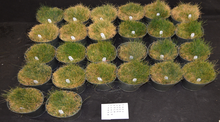Genotypic variation in heat tolerance and post-stress recovery for hard fescue
By Cathryn Chapman and Bingru Huang, Rutgers University
Heat stress can limit the growth of cool-season turfgrass species and inhibit important metabolic processes and functions, which can negatively impact the overall aesthetic qualities of the turfgrass canopy. Damages to the turfgrass canopy due to heat stress can be severe and permanent if turfgrass plants experience prolonged temperature conditions that are above the optimal level.

